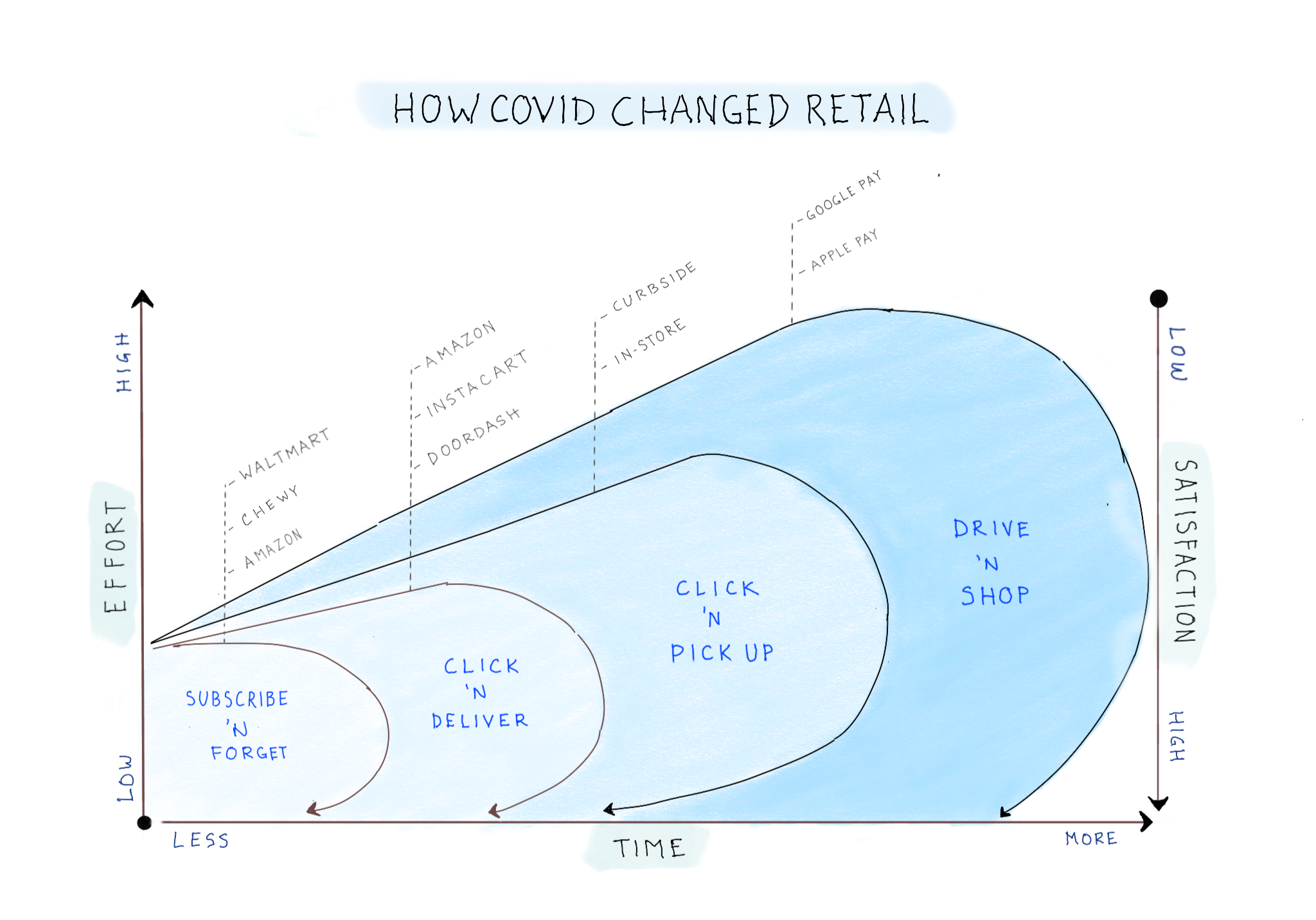The transformation in retail that started in 2020 is not about new trends. Rather, it is defined by mass adoption of services that were previously offered by only selected retailers. The new purchase journey now takes four distinct paths: 1) drive and purchase – travel to a brick-and-mortar store; 2) click and pick – purchased online and pickup at the store; 3) click and deliver – purchase online and have the item delivered; and 4) subscribe and forget – subscribe online and have the item delivered a regular interval (CPG brands). Consumers have adapted to these services and clearly see trade-off between time/effort and money. The retailers that will come out on top will be those that can offer the most frictionless purchase journeys.
Notebook Thoughts: Using The AI to Transform Talent Acquisition
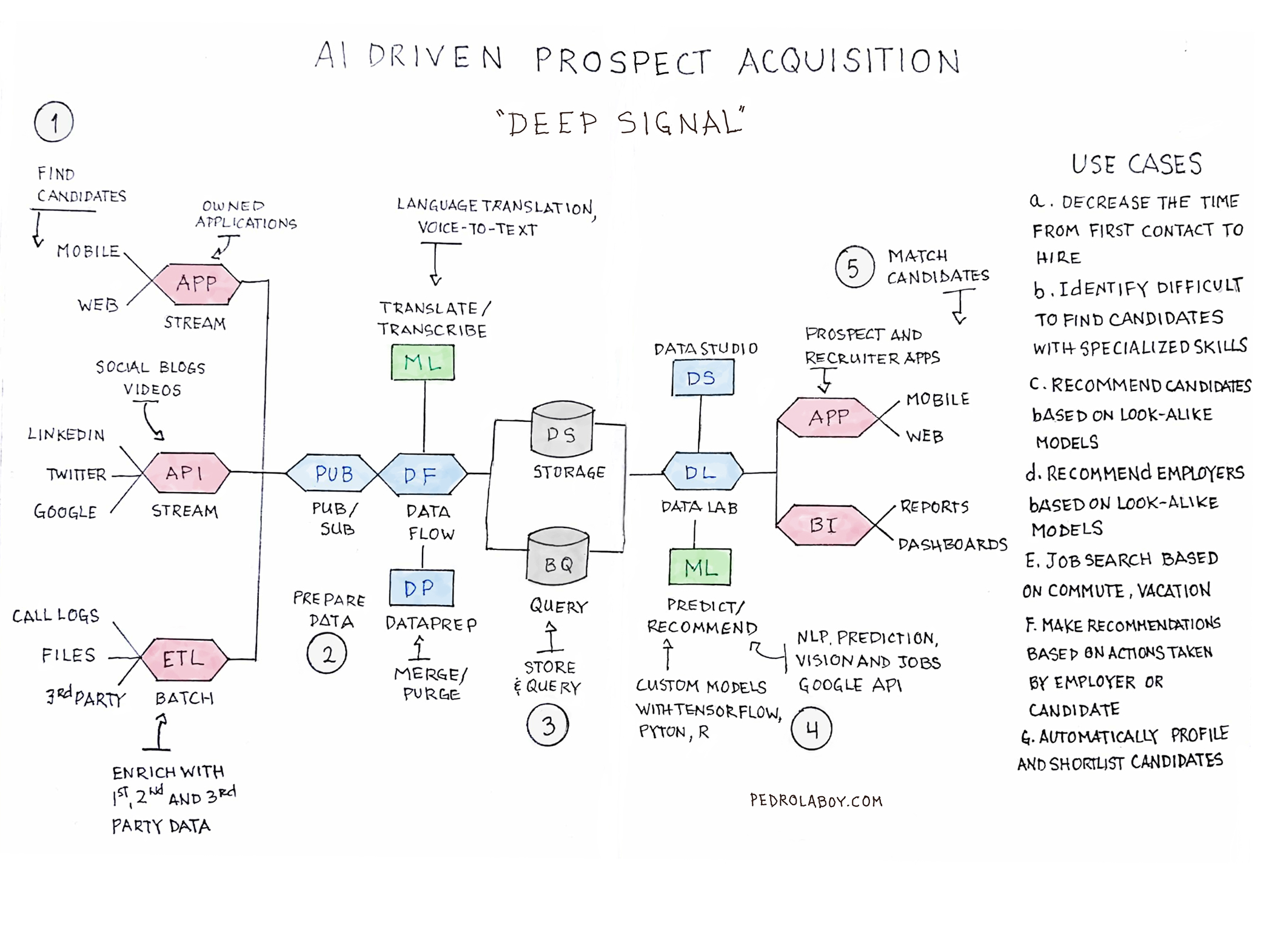
Every HR department and talent acquisition agency knows that in today’s tight labor market it is extremely difficult to find the talent that meets the organization’s business needs. In other words, the way we go about matching talent to job openings is still pretty much in the dark ages. For employers, the process is slow, expensive and labor intensive. For applicants, it is often difficult to find open positions that are a fit.
However, today we can leverage artificial intelligence (AI) and machine learning (ML) to transform the way we match talent to employers. An AI/ML solution could be built using multiple technologies but using the Google or Amazon Cloud offers cost savings, scalability and speed that few can match.
The above is a sketched architecture of what the platform could look like using the Google Cloud. I will call this solution Deep Signal.
Sample Use Cases
So, what could you do with Deep Signal? Here are a small sample of use cases:
1. Candidate Sourcing and Placement – Source candidates faster and more accurately (decrease the time from first contact to placement)
2. Source Specialty Candidates – Identify difficult to find candidates with specialized skills
3. Candidate Recommendation Engine – Recommend candidates based on look-a-like modeling (if you liked this resume, you will also like these other resumes)
4. Employer recommendations Engine – Recommend employers based on look-a-like modeling (if you are interested in this employer, you will also like these other employers)
5. Smart Search – Job search based on non-traditional features (commute time, vacation, etc.)
6. Next Best Action – Make recommendations based on actions taken by employer or candidate
7. Identify Prospective Clients – Identify prospective clients based on existing candidate database (this prospective employer will be interested in these candidates)
Technical Requirements
There are two things that will be needed in order to build a AI driven platform. The first one is data. Without extensive categorical and historical data, you cannot build accurate machine learning models. The second thing we will need is computing power. Without enough computing power, it could take weeks or months to run our models. Both Amazon and Google offer solutions with more than enough computing power to handle anything you throw at them.
Final Thought
Transforming into a data-driven business model based on machine learning and artificial intelligence requires more than deploying new technologies. It often requires cultural and organizational shifts as the business adapts to the realignment of data, people, process and technology.
As always, questions and thoughts are welcome. If you give me a use case and I will think of ways ML/AI could be used.
Notebook Thoughts: Choosing the Right AI Algorithm for the Right Problem
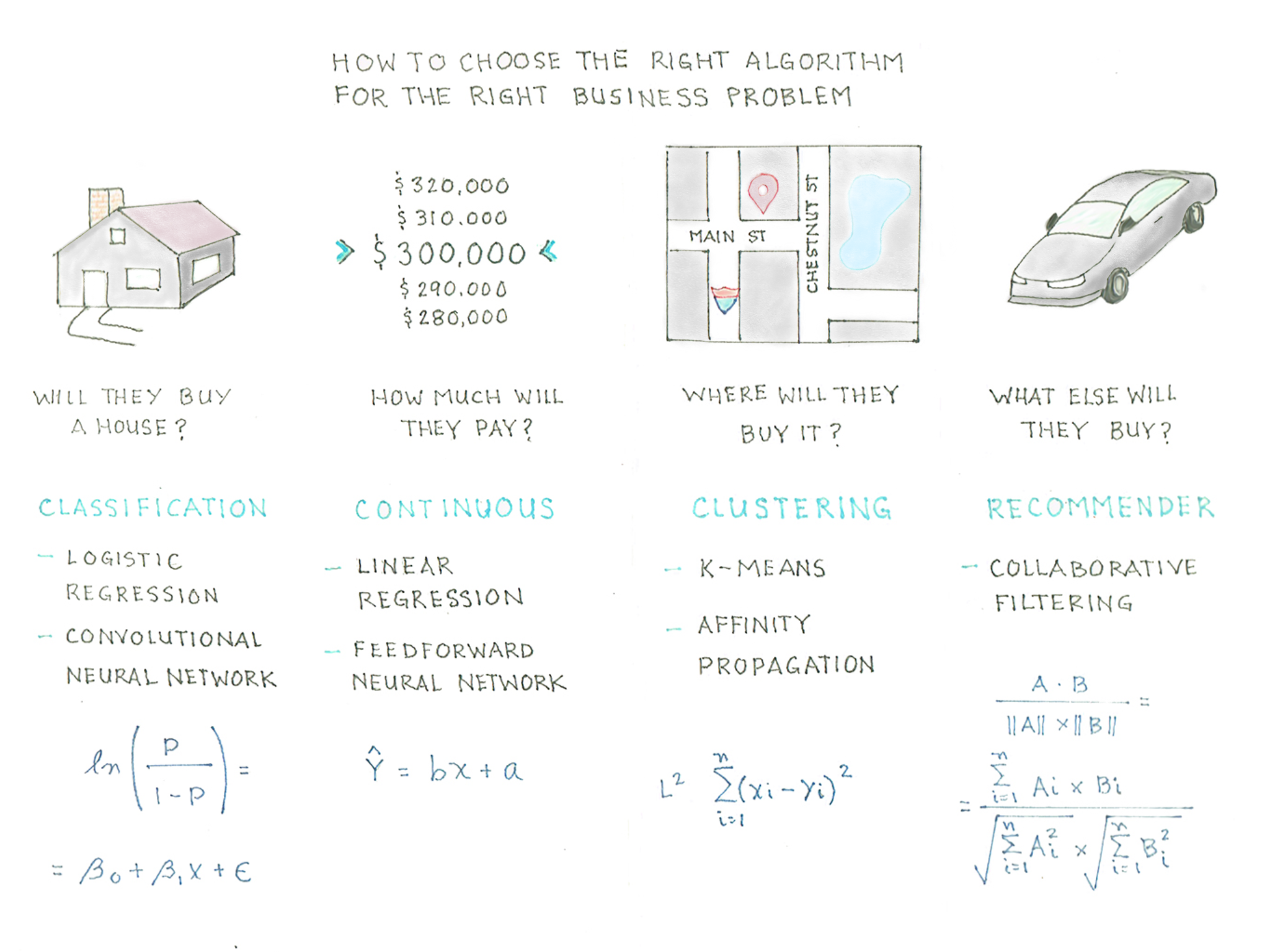
There are countless algorithms we can used to mathematically predict an outcome to a business challenge. However, the most widely used algorithms will fall into four categories: classification, continuous, clustering and recommendation.
Let’s use a real life example to illustrate how we choose the right algorithm to solve the right problem. For illustration purposes we are making a number of assumptions to keep things simple for the non-analyst.
Let’s say that a realtor is trying to answer the following questions:
- Will a couple buy a house? Here we are looking for a categorical answer of Yes or No. For this we would use some kind of Classification algorithm, which could include: Logistic Regression, Decision Trees or Convolutional Neural Network
- How much will they pay of the house? For this question we would use Continuous estimation as we trying to determine the value in a sequence. Is this case, one would likely use a Linear Regression algorithm.
- Where will the buy the house? Clustering would be the best approach to determine where they are likely to buy a house. K-means and Affinity
- If they buy a house, what else will they buy? Recommender System Algorithms are commonly used to determine next best offer or next best action. The most commonly used Recommender algorithm is Collaborative Filtering: either user-to-user or item-to-item.
Notebook Thoughts: The Four Phases of Digital Transformation

A new business paradigm is forming, one that aligns business intelligence, creativity, big data and technology to deliver relevant connected experiences to a new generation of hyper-connected consumers. To succeed in the coming years, companies will need to fuse together a myriad of technology platforms, segregated business data, and a somewhat ineffective media landscape to reach Millennial consumers and the generations that follow.
From crawling to flying, the journey to becoming a data driven organization that can deliver connected experiences has four distinct phases. Each of these transformational phases are enabled by five core drivers: data, technology, intelligence, content and experiences.
Notebook Thoughts: 15 Trends That Are Disrupting Marketing
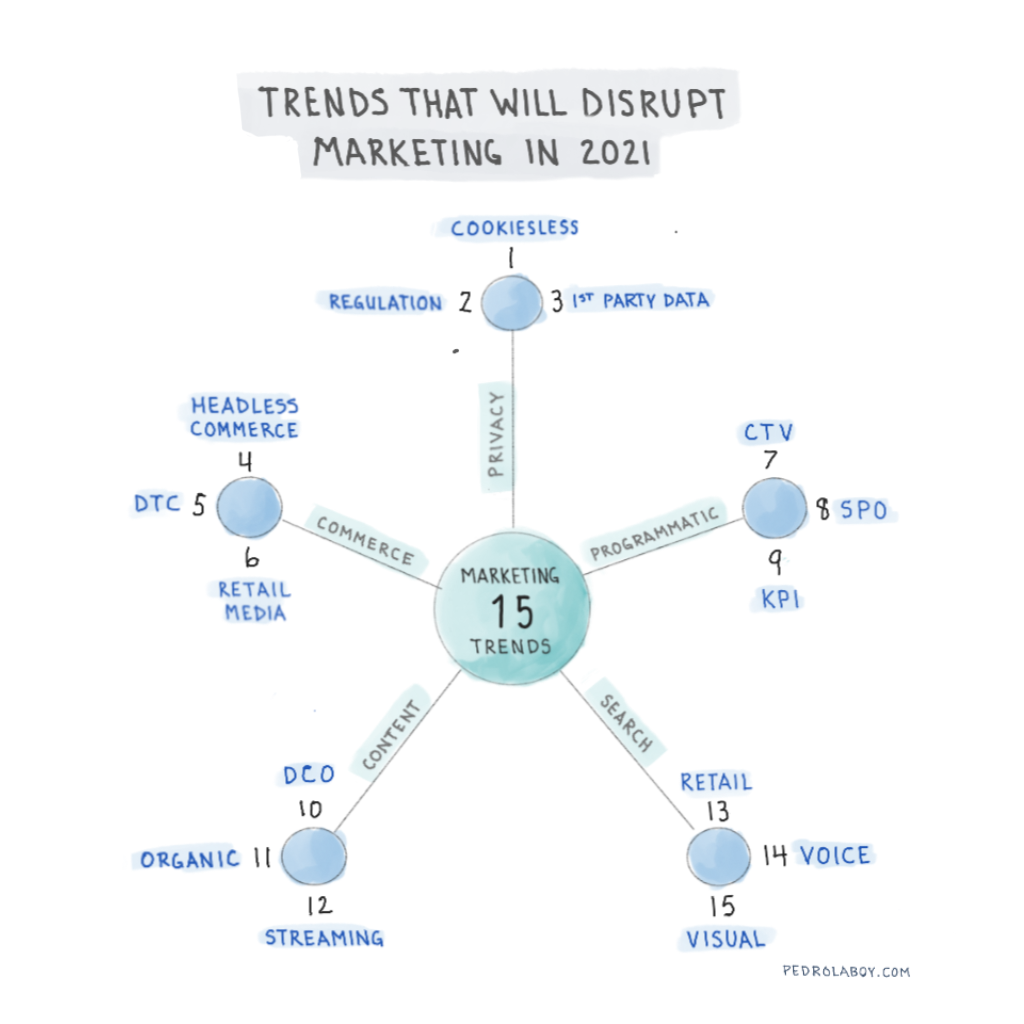
Privacy and Data:
- The Cookie Crumbles – With Google following on Apple and Mozilla’s steps and putting in motion plans to phase third-party cookies, marketers will have to reassess how they track and target customers. Apple’s coming changes to its Mobile OS tracking policies will only compound the problem for brands. While we don’t know exactly what will replace third-party cookies (i.e. Sandboxes, FLOCs, etc.), content will be king and contextual targeting will make a comeback.
- GDPR and Privacy Regulations – The effects of GDPR have been felt far beyond the EU as brands embrace it as the gold standard to safeguard consumers’ privacy. In the US multiple states have introduced laws similar to California’s CCPA. Furthermore, Japan, India, Canada, Brazil and Korea have passed privacy laws similar to GDPR. In 2021, governments across the world will continue to enact stringent privacy laws.
- First Party Data and Universal IDs – These changes will force brands to either develop robust first-party data assets or be at the mercy of Walled Gardens—likely both. 2021 will see significant investments in the technology infrastructure and partnerships needed to build these assets. Another way to counter the Walled Gardens will be to use Universal IDs from vendors such as The Trade Desk, the Advertising ID Consortium or ID5. However, until an industry standard is accepted, identity management will be something marketers will have to focus on.
Ecommerce:
- Headless Commerce – Headless commerce, which is the decoupling of backend and frontend operations, is a must of any brand that wants to compete in digital commerce. One area where marketers need to quickly pivot is social as it has it shifts from being a mostly brand channel to becoming a performance medium. For more on headless commerce, see my other post.
- Direct to Consumer – One of the doors that headless commerce opens, is that it makes easier to CPG brands to bypass retailers and sell direct to consumers. From Procter & Gamble to Colgate, CPG brands are rushing to build the infrastructure needed to reach consumers directly. This will also require that CPG marketers expand their skillset.
- Retailers as Media Networks – Another trend that will continue to proliferate is that of retailers becoming their own media networks. This is a strategy that Amazon mastered early on and now other retailers (i.e. Home Depot, Target, Walmart, Instacart, etc.) are trying to mimic. These retailers are now becoming mini walled gardens. In 2021, the retail media landscape will continue to fragment and marketers will have to deal with a more complex media landscape.
Programmatic:
- Connected TV – Connected TV is expected to grow 30% to 205 million users by the end of 2021. With a myriad of vendors now offering solutions that allow for the delivery of targeted content both dynamically and programmatically, marketer must rethink content and strategies.
- Supply Path Optimization – Although it is not something new, the proliferation of SSPs and DSPs has made programmatic supply path optimization (SPO) a priority for 2021. SPO has two major components. On one hand, it consolidates and prunes inefficient SSPs. On the other hand, is uses machine learning to determine the most optimal path to inventory.
- Business KPIs – As the current recession puts pressure on marketing budgets, marketers are demanding that programmatic strategies be optimized to business performance indicators and not simply impressions, clicks or engagements. Machine learning now gives marketers to optimize their media buys based on content, product inventory or profitability.
Content:
- Dynamic Content Optimization – Investments in technology and data will not only allow marketers to identify the right consumers but also to deliver content and messaging dynamically and at scale through Dynamic Content Optimization (DCO). Today, this is easier than ever for both small and large brands. For example, marketer can use solutions from Adobe, Salesforce, and Oracle to dynamically manage content in their digital properties and at the same time use solutions from Flashtalking, Jivox and Sizmek to optimize their media content.
- Organic – Creating, managing and optimizing organic content should be at the top of any marketing strategy for 2021. One catalyst for this will be Google emphasis on its EAT (Experience, Authority and Trust) algorithm. Under EAT, Google will give higher ranking to pages that demonstrate relevant quality and context. Another catalyst is the reduction in paid media and marketing budgets due to the current recession.
- Streaming and Video – The pandemic has brought streaming services, video content and video chat technologies to the forefront. Two trends are of note. First, streaming has become nearly universal so it must be part of every marketer’s strategy. Second, the subscription model will not be enough for all players to survive. Thus, advertising opportunities will be abound and the largest of these streaming services will become walled gardens. Finally, the introduction of 5G technology will mean that streaming content will be increasingly consumed through mobile devices.
Search:
- Retail – Google might still be king of the hill when it comes to search but it is no longer the only name in town. In particular, when it comes to products 54% of searches now take place through Amazon. As more retailers become media networks, search strategies can no longer focus solely on Google and must include a multi-pronged approach.
- Voice – 50% of consumers a currently use voice search and by the end of 2021 sales of smart speakers will surpass that of tablets. Marketers will have to rethink their keyword query strategies and take into account speech patterns as they integrate voice into their search marketing strategies.
- Visual – Given that 90% of all information processed by the brain is visual, Visual Search is the natural evolution of where consumers are going. This is already the case in 2021. For example, there are over 600 million visual searches on Pinterest every month and Google Lens has reached 500 million downloads in the Play Store. Marketers must now take into account how consumers visually search and how the consume/use visual search returns.
Notebook Thoughts: Understanding Headless Commerce
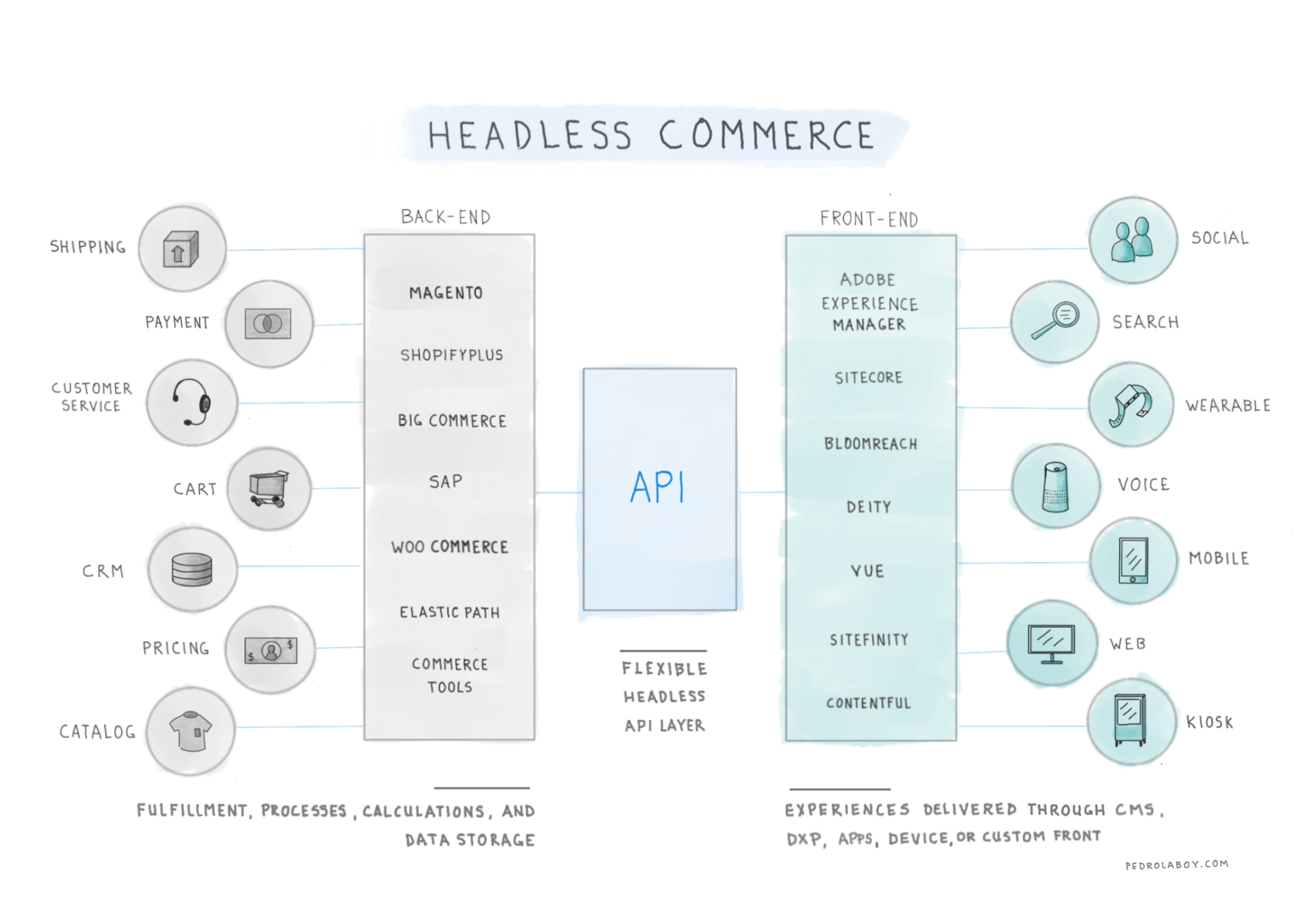
Headless commerce decouples back-end platforms responsible for fulfillment, operations, processes, calculations and data from front-ed platforms responsible for delivering experiences through technologies such as CMS (content management systems), DXPs (digital experience platforms), PWAs (progressive web applications) or custom solutions. One can say that the back-end is “headless” and front-end offers multiple “heads.” This is made possible through the use of a flexible API layer
Notebook Thoughts: Media Agencies’ Ansoff Matrix
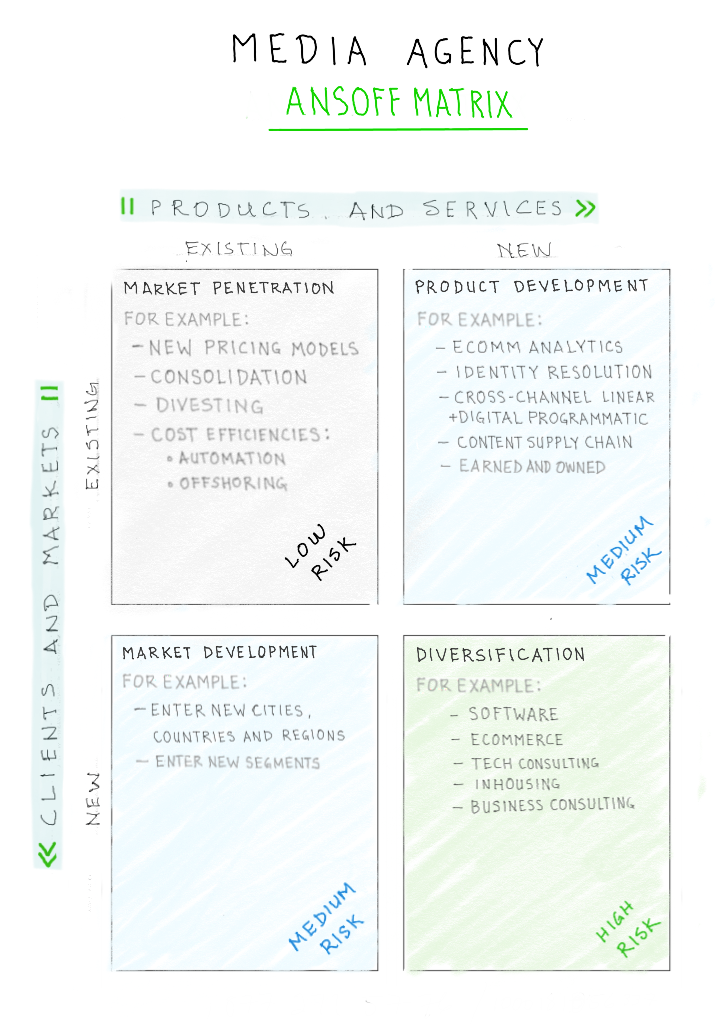
Recently, I was having a conversation with a friend about strategic choices and risks in our industry. The best way to map the two is to think of them in terms of the Ansoff Matrix. Ansoff argued that business growth can only come from two sources: new products and services or/and new clients and markets.
Market Penetration – One can grow existing clients or win new clients in your current market by offering a better value propositions. These could include new pricing models, efficiencies through consolidation or lower costs through off-shoring or automation. This is considered a low risk strategy.
Product Development – One can create new products and services that complement the existing suite. These could include ecommerce analytics, identity resolution, digital/linear cross-channel programmatic or new products around content creation and management. This is considered a medium risk strategy.
Market Development – This one is straight forward. Grow business my entering new markets with existing and/or new products and services. This is considered a medium risk strategy.
Diversification – One can develop brand new products and services that are outside the current areas of expertise. This could include tech consulting, software development, ecommerce management, or in-housing solutions (within expertise but can cannibalize existing services). This is considered a high risk strategy.
Notebook Thoughts: Using Social Media to Measure Brand Health
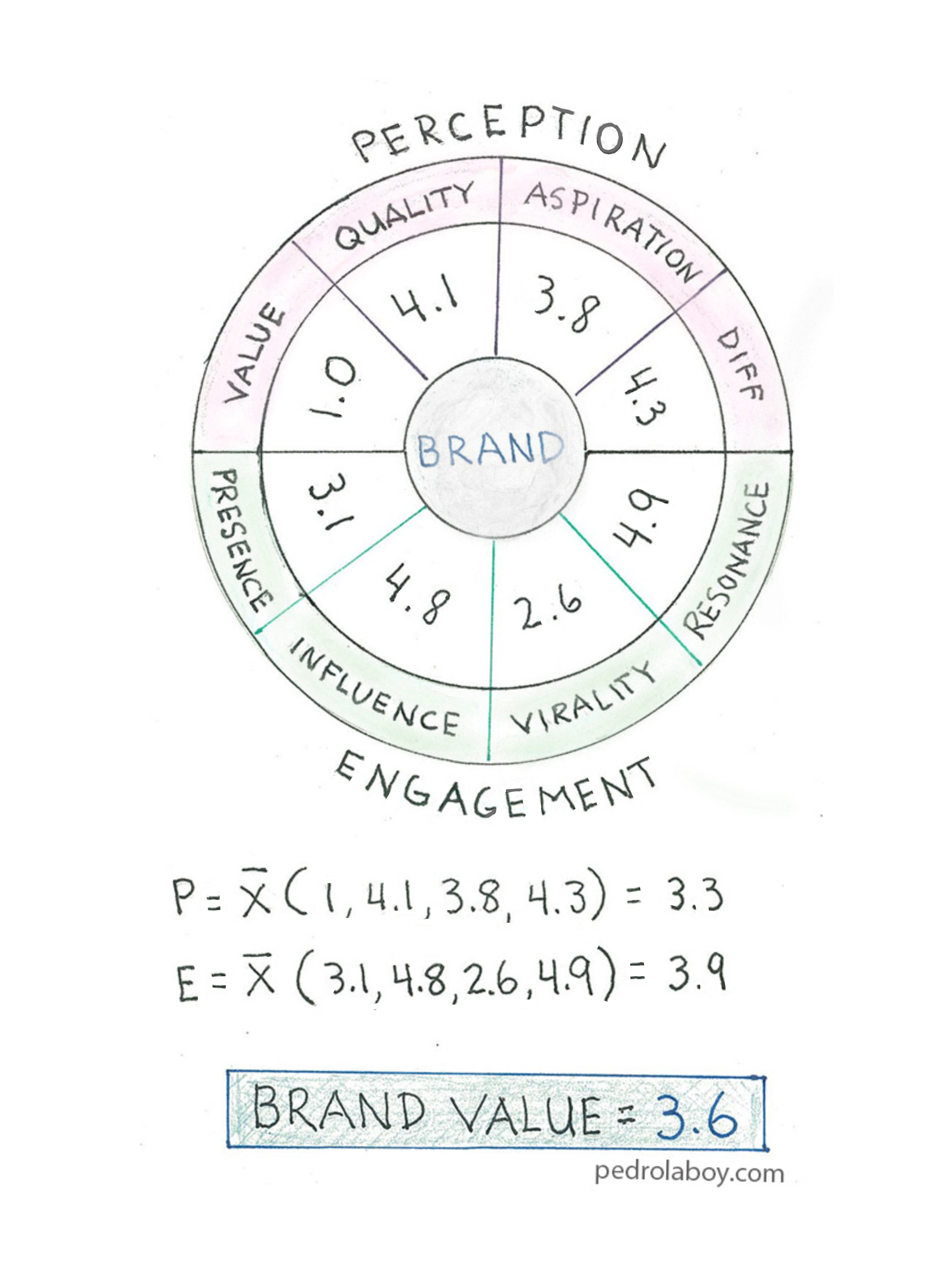
Rather than using sentiment as a proxy for brand health, we should embrace a new model that measures the health of brands in the context of the competitive set and category ecosystem. The model looks at two core areas; Perception and Engagement. On the Perception side we focus on key areas that define thoughts and feelings about the brand. The Engagement side quantifies the reach and strength of the brand and its messaging. All volumes are weighed against sentiment, to ensure that brands are not rewarded for negatively driven spikes in activity. Both Perception and Engagement consist of four distinct areas of measurement:
PERCEPTION
- Value: perception of the usefulness and benefit of a product compared to the price charged for it
- Quality: general level of satisfaction with the way a product works and its ability to work as intended
- Aspiration: expressing a longing or wish to own the product or to be associated with the product’s qualities
- Differentiation: the extend to which social media users draw distinctions between the qualities and characteristics of the brand and its competitors
ENGAGEMENT
- Presence: the size of a brand’s owned social communities weighed with the sentiment expressed by the community members toward the brand
- Influence: the ability of a brand to earn unaided mentions as well as have its messaging amplified and shared by the social media community
- Virality: the number of unique people engaged in conversations with or about the brand; weighed with the sentiment expressed by those users
- Resonance: the ability of a brand to engage users with its content and elicit reactions from them

